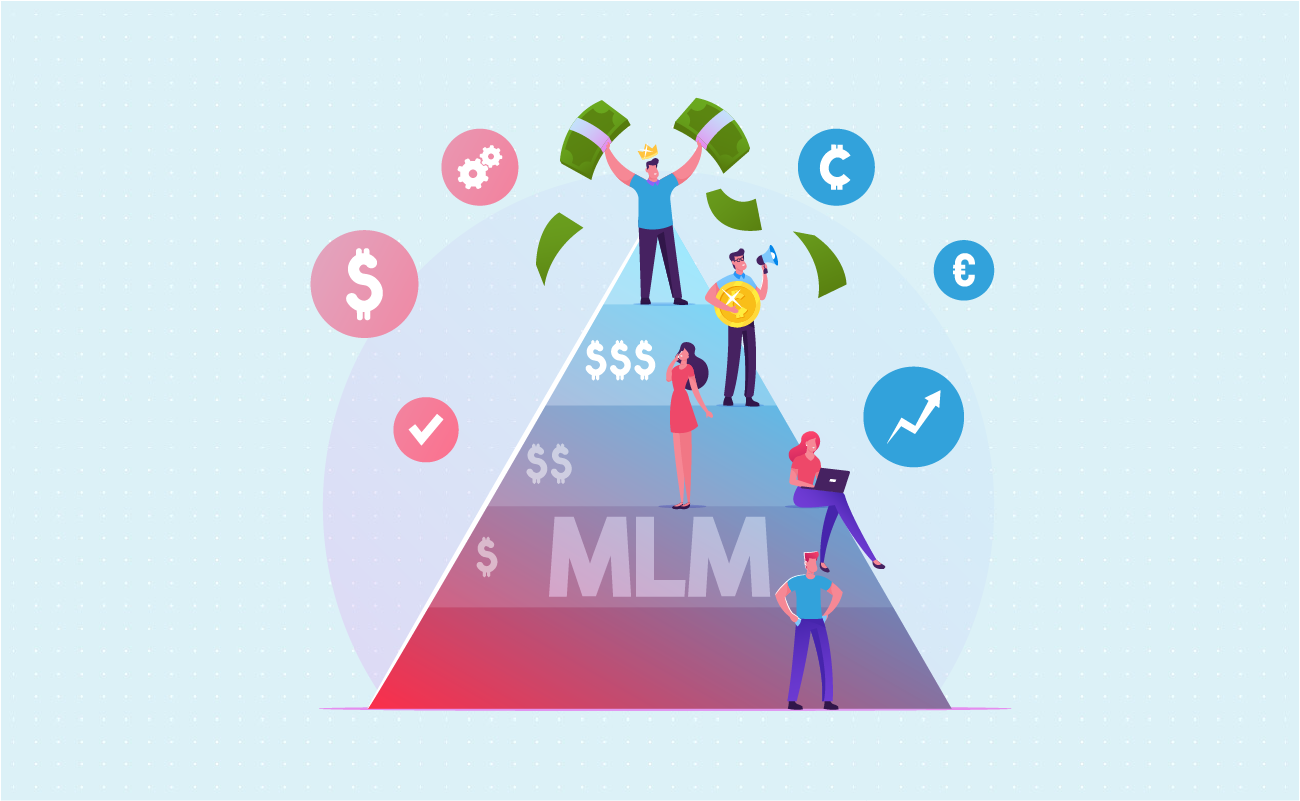 MLM Downstream Member Calculator
MLM Downstream Member CalculatorThis simple calculator helps people participating in multilevel marketing schemes estimate the size of their downstream & the potential estimated monthly commission they could earn.
Enter the amount of personal volume you expect each partner to produce, how many members you expect each member to recruit in the following downstream level, what percent of members you expect to recruit others & we will automatically estimate the downstream size.
After entering your initial estimates you can then manualy adjust the commission levels by tier & any other stats. This calculator is helpful if you want to automatically estimate downstream size by tier, but if you want to manually enter the data you may prefer our MLM commission calculator.
Be warry of any program which has large upfront fees and tells you how much you will earn 20 levels deep. If each member managed to recruit 4 other members then by the time you get to the 20th level there would be 1,099,511,627,776 members at that tier. Unfortunately for that math, there are not that many people alive today. The world's population today is around 7.7 billion and 100 billion people have lived throughout human history - less than 1/10th the above calculation.
Guide published by Jose Abuyuan on February 29, 2020

Mention multilevel marketing (MLM) and the first thing that comes to mind is “pyramid scam.” There is a huge overlap between the two terms. One is legal, the other is not. Not helping things is that actual pyramid schemes often hide behind the MLM label.
Although it is possible to succeed in MLM, it is an uphill battle. The way the systems are arranged have made it difficult to break even. If you don't think you can play this retail game, you might be better off trying your luck elsewhere.
The pyramid scheme is a variation of a scam codified by infamous Italian swindler Charles Ponzi. Every Ponzi scheme pays older investors with the contributions to newer ones. It's summed up thus: steal from Peter to pay back Paul.
Pyramid schemes make recruitment an active point. Each later member must recruit at least two more to gain any money. This toxic pyramid enriches those on top at the expense of the newcomers at the bottom. With no external way of generating any money, this scheme is always destined to collapse. The fallout leaves the most recent members with the biggest losses. The founders, meanwhile, take off with their money. The math required to keep a pyramid scheme does not add up. To keep going, a pyramid scheme would need to recruit more people than the world's population. There may be a sucker born every minute, but there are nowhere near enough suckers on Earth.
Both pyramid schemes and MLM enterprises hinge on profiting off recruitment. Many MLM companies make a big deal out of gathering downlines. These are incentivized through referral bonuses from distributors. Each sale and recruitment referred by those below earns the distributor a small commission.
These companies claim that rapid deployment is the best way to distribute their products. Incentivized recruitment expands their market reach and workforce. This also offloads the cost of promotions to the members themselves.
Too often, many MLM enterprises make wide assumptions of their market. Critics have claimed that MLM businesses are predatory. They point out that newer distributors are often at a disadvantage compared to their recruiters. For the most hostile of critics, all MLMs are nothing more than rebranded pyramid schemes.
Why, then, are MLMs legal? There is no one set of legislation that codify an MLM as a legitimate business. Most regulatory bodies, however, make one important distinction.
Pyramid schemes are financial dead ends. There was never anything in them to generate income. Nominally, an MLM can make money outside recruitment. An MLM's primary business is still the product it sells through distributors. The recruitment system is used as a strategy for aggressive expansion. And for many, well-established MLM brands, the claims are legitimate.
The distinction has become harder to see nowadays. Many less scrupulous MLM enterprises shift their focus on recruitment. Not a few of these have turned distribution into an afterthought. Some business models became so toxic that selling a product is an afterthought.
This very small difference has allowed unscrupulous pyramiding companies to mask their operations. Not a few MLM companies have later been revealed to be pyramid scams.

Multilevel marketing did not become a distinct business model overnight. Its roots emerged from direct selling companies. Many of today's more legitimate MLMs are still direct selling enterprises at their core. Instead of stores, direct selling companies recruit distributors, who sell the products to a local client base. The distributors act as small-scale franchisees.
The first direct selling enterprises emerged in the 1950s. This system has been recognized as a legitimate business model for several years. A few of the earliest brands—including Avon and Tupperware—are household names today.
The direct selling model was a product of the suburban boom. More of Middle America settled away from retail areas in the 1950s. Many fashion-savvy suburbanites found it difficult to do their shopping. Societal expectations also meant married women had few opportunities to earn money.
Direct selling solved all these things and more. Housewives could sign up to become distributors and sell their wares to their neighbors. These distributors brought shopping to the comfort of their neighbor's homes. Before Amazon, there was Avon.
Low overhead is another key advantage. Signing up to an MLM costs way less than most franchises. You also don't need to set up an expensive brick-and-mortar shop and market your goods. Your neighbors will likely be your first customers, as it was in the olden days. And money isn't the only reward. Avon's top sellers, for instance, get vacations as incentives. Mary Kay cosmetics rewards its top performers by leasing a fabulous pink convertible.
Then as now, the appeal of MLM companies come from every person's desire to free themselves from the rat race. Greedy business people have made the reasonable work weeks a thing of the past. Millennials and Gen Zs entering the workforce often need a side gig just to make ends meet. The MLM is marketed to these demographics as a lucrative side job.
The direct salesperson today has plenty of opportunities to make a profit. Platforms like Amazon let you build an inexpensive online storefront. Sites like Pinterest and Facebook also create opportunities to market goods to an interested audience. You are no longer limited to peddling stuff only to your friends and neighbors (to their relief).
What most people fail to realize is how difficult selling is. Most MLMs sweeten the pot by giving you the opportunity to make money off the commissions of someone else's sales. The stronger the performance of your network, the stronger your own business. You can probably see where this is going.
Today, about 99 percent of MLM recruits end up losing money. In some cases, these losses are catastrophic. Too many get roped into buying too much inventory or putting up appearances that they get into debt.
At the end of the day, however, a direct selling business is still a retail enterprise. You'll need to approach your franchise like you would a “traditional” selling business.
Before you even think of entering, consider the market for your product. Are there enough willing customers to make this business flourish for the long term? There's only so many plastic containers, pantyhose, and cosmetics a person can buy. Demand will taper off eventually.
This goes double for your downlines. Unless you've mastered the art of persuasion, you won't have a lot of new recruits for long. The payouts of both an MLM and a pyramid scheme are often highest during the first month alone. This segues to our next problem.
The suburban milieu of many MLMs mean that even the healthiest markets will taper off. There aren't enough people in the suburbs to sustain specific retail business. Without any market research, you wouldn't know when and where to sell your goods.

Inventory matters. A good MLM company would have a reasonable buy-back or return policy for inventory items. One way to tell if a company is a shady pyramid scheme in disguise is if they lack the option to buy back inventory.
One of the biggest challenges faced by the MLM is how recruitment scuttles the ability to sell. Downlines saturate a market. You find yourself in a neighborhood where hundreds of people sell the same thing. By encouraging downlines, MLMs inadvertently concentrate their distributors close to one another.
A lot of sellers might be good when demand is still high. It is at this point that many people get rich from this. Too many sellers in the same place exacerbates the problem of tapering market demand. The incentive economy also means that newer distributors must work harder to gain the same returns as their predecessors.
In theory, an MLM's commission system lets you make as much money from the performance of your downline team. For that to happen, they must be good salespeople. The general understanding is that you build up the performance of your sales team. Over time, commissions from their sales and recruitment make you as much money as your own sales.
The people often recruited by MLM distributors are those they already knew. This is a cynical numbers game that rewards volume. This focus on quantity over quality creates downline networks that don't sell well.
Worse still, you might not even be an adept salesperson yourself! Past your family, friends, and regulars, people probably think you're very annoying.

Be wary of MLM communities with toxic internal cultures. Some distributors harangue their downlines to buy more inventory. Besides crippling debt, people dealing with this also experience psychological distress.

The MLM industry is rife with pyramid schemes masquerading as legitimate businesses. A big name is no guarantee of legitimacy. Screen each prospective MLM business with care. It pays to look at this business model with a large dose of skepticism.
The first thing to look out for in an MLM is superficiality. They are likely to overdress and create an illusion of wealth. If you see instructors wearing expensive clothes or flashing status symbols, beware. Often, the company's marketing encourages its members to “dress for success.”
Here are a few things to watch out for in an MLM company:
Be aware of the type of product you are meant to sell. A reputable MLM would have a product people would use in real life. Some of these include clothing, cosmetics, and household items. These products are easy to consume and easy to distribute. An MLM company you can trust would include consumer research in its sales strategy.
Nutritional supplements are a borderline case. Because they're not regulated, just about anyone can manufacture and sell them. Even if the company selling them is legit, they're still harder than the usual product to sell.
Pyramid schemes masquerading as MLMs have no interest in market research. The product is often a front, existing solely to throw off government suspicion. This could explain why many of them are difficult to sell.

As attractive as MLMs are on the surface, they have as many risks as any other business. Contrary to what their brochures would say, “MLMs” are not easy money. They are, potentially, profitable ventures if done well. You'll need to avoid some of the common pitfalls encountered by MLM distributors.
As with all businesses, you'll need to make a feasibility study to ensure that this business is right for you. Before you say yes to any “business opportunity,” ask questions. Learn as much about the company as you can. A shady company will either focus on recruitment or upsell a lifestyle you could have. When a product is front and center, that's a good sign.

Loving your product is the easiest way to sell it. Find an MLM company that offers a product that you already enjoy using. You'll know the target market better and make more sales in the process. Plus, you'll get the stuff you want at a discount.
Take this path only if you are willing to deal with the difficulties and chores of a retail enterprise. Select your market for expansion and grow with it. Scale down your expectations and treat this as any other business. Learn what's on demand and how to capitalize on it. Be the business owner the MLM ads say you are.
Avoid saturating your market. Seek downlines in new markets rather than concentrate on people near your area. Choose candidates based on how well they take to selling things. Assist your downline recruits to help them flourish in their markets.
One of the selling points of an MLM is the ability to make extra cash. Recruiters often claim that if you work hard enough, you can make more money than your day job. This is a big stretch, but it can give you a fair amount of extra money. If you're not good at selling, on the other hand, you can fall back on your other talents. Here are a few reliable ways to make extra money in your free time.
Entrepreneur.com lists down 75 business ideas to help you earn a little extra income with little to no capital expenditure. Once you've started making that extra moolah, put it to good use.
Jose Abuyuan is a web content writer, fictionist, and digital artist hailing from Las Piñas City. He is a graduate of Communication and Media Studies at San Beda College Alabang, who took his internship in the weekly news magazine the Philippines Graphic. He has authored works professionally for over a decade.